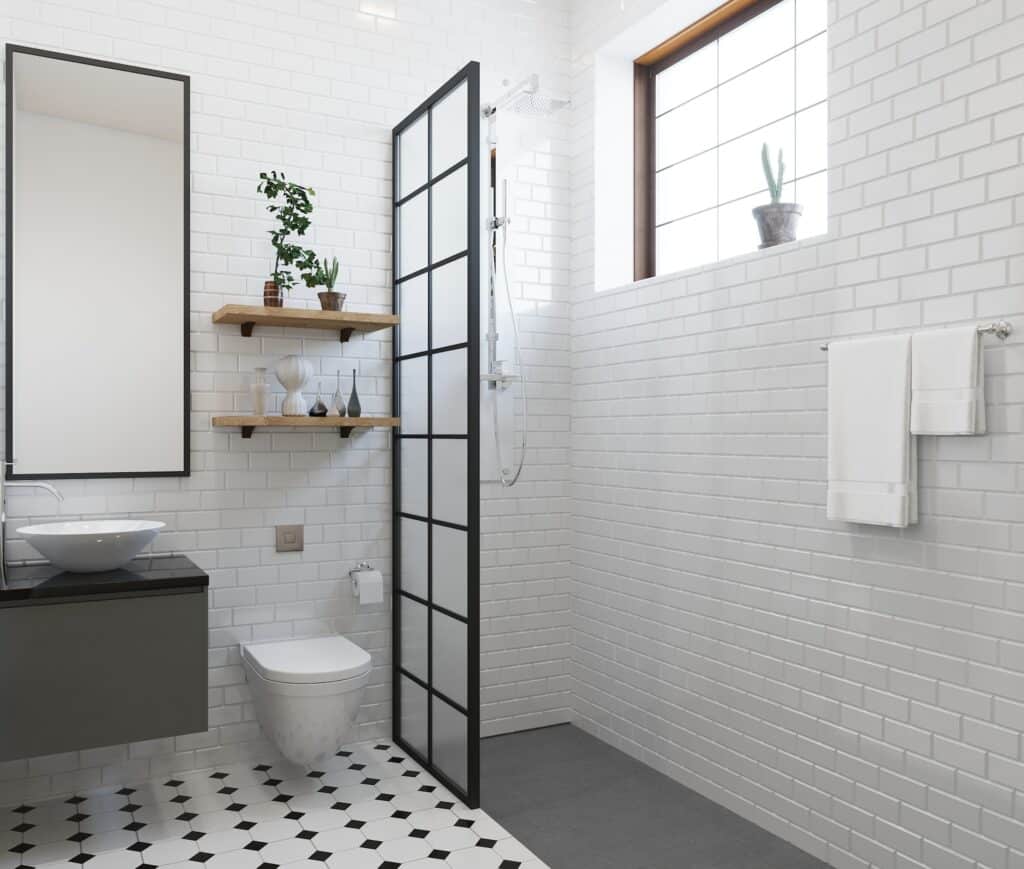It grows almost without you noticing. Even with all the time you spend in the bathroom, you ignore it. Grey or black tinting on the tiles or drywall, slowly moving out from the edge and blossoming.
Especially in bathrooms with showers or tubs, mold growth isn’t uncommon. Without proper pre-treatment and ventilation, the ceiling gathers moisture and doesn’t let go. For spores looking for a home, your bathroom ceiling is an inviting, protected space.
But your bathroom doesn’t have to look like Jennifer Connoly’s in Dark Water. With the right expert on your side, mold removal is a simple process. Let’s examine the sources and remediation of bathroom ceiling mold.
What causes mold on the bathroom ceiling?
Mold spores are opportunists, happy to grow in suitable environments whenever possible. All they need to latch on is oxygen, a food source, and moisture. They thrive in the moist corners of your bathroom ceiling because it usually has all three.
Mildew is the spores that grow on surfaces in your home. Tiles, grout, windows, and the like attract moisture and promote rot. Mold grows in between surfaces like drywall and tile. It’s much harder to manage because it lives inside its food source.
There’s a bit of misunderstanding around black mold. Several types of mold are black, and all release spores. You’ll have a more severe reaction depending on your sensitivity to the spores.
Other than when you’re using the facilities, you probably don’t spend much time planning spring cleaning. But mold loves the out-of-reach ceiling just for that reason. It damages everything it grows on, including drywall, trim, paint, ceilings, and doors. It’ll even invade your bathroom fan!
Poor air circulation can be the source of the mold
We all love a hot shower after a long day of work. Make sure you turn on your ventilation fan and open a window if possible. All that steamy, damp air rises and clings to the ceiling. If your bathroom has poor air circulation, it might cause mold growth.
Additionally, up to 20% of people have a severe mold allergy. Proper air circulation helps clear out pathogens and increase air quality. Poor air movement makes it even worse if you’re already dealing with mold growth.
There could be a leak somewhere causing mold to form
Cracked or leaking pipes behind drywall or between floors may also cause mold and mildew to flourish. A slow leak saturates building materials over time, allowing growth to penetrate deeply. You might have a leak if you notice a spot in the ceiling that isn’t ordinarily damp.
Products to help get rid of mold
Read this before you pick up that bleach spray and start going to town on your ceiling tiles. Chlorine bleach kills bacteria. Mold and mildew are fungi and aren’t affected by the powerful cleaner. Instead, you’ll need cleaners that kill the spores and remove the stains.
Many of the best products for mold removal are in your pantry. Look here for the best, time-tested tools. Best practices when dealing with mold suggest wearing an N95 face mask for safety.
Hydrogen peroxide is great for mold removal
You’ve used hydrogen peroxide to clean wounds. The stinging sensation and bubbling clear out
debris and kill pathogens. But it also works on mold and mildew! Studies show that the solution breaks down the proteins in molds and fungi, effectively killing them. Apply it to the affected area and scrub away!
However, it only works on surfaces. For porous surfaces, you’ll need to look elsewhere.
White vinegar is surprisingly effective against mold
Acetic acid, or white vinegar, disrupts the pH balance of mold and mildew. Using it for cleaning purposes might leave behind a funky odor, but at least you know the spores are dead.
Using a spray bottle, apply undiluted vinegar onto a mold spot and let it sit for around an hour before cleaning. Do not mix hydrogen peroxide and vinegar; they react badly when mixed. Peracetic acid forms and may be toxic if inhaled.
Baking soda can help when mixed with other solutions
Baking soda works similarly to vinegar, disrupting the pH balance of fungal organisms. Mixing a tablespoon of baking soda into a cup of water creates a cleaning solution that may be sprayed onto mold. Saturate the area with the solution and let it sit for 10 minutes before cleaning.
How to prevent the return of mold in the bathroom
Once you’re sure you’ve dealt with the mold and mildew problem in your home, don’t stop looking. Mold is pernicious and won’t just quit coming back unless you’re on guard. A few steps will help ensure it doesn’t ruin your freshly clean space.
Make sure the bathroom is properly lit
Leaving a light after your shower may reduce the recurrence of mold in your bathroom. Mold thrives in the dark, and certain types of light disrupt the DNA of spores as they grow. UV light rays kill the organisms, and there are special mold-killing light bulbs at home goods stores. Especially on the ceiling, lighting plays a significant role.
Prevent moisture from building up to avoid mold in the bathroom ceiling
Run the exhaust fan in your bathroom during and after your shower for 15 minutes. Warm, moist air travels up and settles in the corners naturally. A good fan, and an open window, can keep moisture from building up on your ceiling. If you don’t already have one, it’s an easy install and worth the investment.
Consider contacting a professional to find the source of the problem
It’s frustrating to do everything you can to solve a problem that just won’t quit. Attempts at mold remediation can drive you up the wall, especially if you can’t figure it out. When things have gone too far, it’s time to call the professionals.
Certified mold remediation specialists will be able to help you! Not only will they help with water damage, but they’re also trained to get rid of mold and mildew. Your local professional will make sure it’s gone for good.
UES is here to address any questions or concerns about mold for you!
Serving the entire state of Florida with authoritative Mold Assesment, we are your trusted mold company.
Contact us today to learn more about our mold related services.


